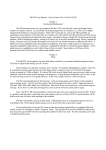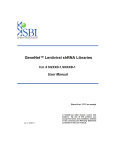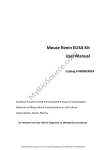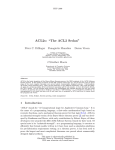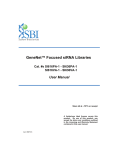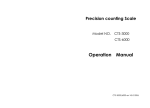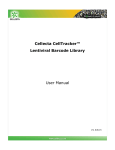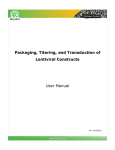Download DECIPHER User Manual
Transcript
Cellecta, Inc. 320 Logue Ave Mountain View, CA 94043 www.cellecta.com 650-938-3910 DECIPHER User Manual Genetic Screens with Pooled Lentiviral Bar-Coded shRNA Libraries Table of Contents Page A. Background 1 B. Required Materials 3 C. Packaging Protocol for Lentiviral shRNA Libraries 5 D. Pseudoviral Titer Estimation 7 E. Protocols for Genetic Screens with Pooled Lentiviral shRNA Libraries F. Examples of HT RNAi Screens 9 10 G. Genomic DNA Extraction for Bar-Code Amplification and HT Sequencing 12 H. HT sequencing of Pooled shRNA-specific Bar-codes in Illumina’s Genome Analyzer (GAIIx) or HiSeq 2000 HT Sequencing Platform 15 I. Bar-code Enumeration (Conversion of raw sequencing data to number of reads for each bar-code) 15 J. Statistical Analysis of shRNA hits enriched/depleted in genetic screen 15 K. Interpretation of genetic screen data 15 L. 16 Troubleshooting M. Technical Support 18 N. Safety Guidelines 19 O. Cellecta Limited Use License 20 P. 21 References A. Background The protocols below provide the instructions on how to package, titer, and transduce target cells with pre-made DECIPHER or custom pooled lentiviral shRNA libraries. Also provided are examples for both positive and negative selection screens. Additional protocols provide guidelines for the preparation of bar-coded probes for high-throughput (HT) sequencing and analysis of raw sequencing data sets. Please read the entire user manual before proceeding with your experiment. Designing and Performing HT RNAi Genetic Screens Specific screening protocols will vary depending on the particular biological mechanism to be studied. For general information and examples of successful genetic screening experiments, we recommend that you refer to the References in Section J. Although the specific protocol and controls may be different depending on the cell type, functional assay, and selection protocol (e.g., FACS, apoptosis induction, toxic chemical survival, etc.), it is critical to carefully design your experiment in order to generate statistically significant data. With this in mind, consider the following suggestions when setting up your experiment: Model Phenotype Selection with Positive Control shRNA Construct(s). Before performing a large scale genetic screen with a pooled lentiviral shRNA library, we suggest making several shRNA constructs designed against one or more particular target genes whose inactivation is known to elicit the desirable phenotypic changes in the target cells. Then, by Tech Support: [email protected] 1 of 27 v.7a, 7/28/10 Cellecta, Inc. 320 Logue Ave Mountain View, CA 94043 www.cellecta.com 650-938-3910 packaging and transducing these positive control shRNA constructs into target cells, you can optimize the protocol for enrichment/depletion of cells with induced phenotypic changes for your experiment with the shRNA library. As negative control cells, which should not be enriched/depleted during the selection steps, you can use cells infected by non-targeting shRNA constructs (e.g. against Luciferase, or a scrambled shRNA control). The packaged positive control shRNA constructs can also be added to the shRNA library in a ratio of about 1:1,000 Transduction Units (TU)—also known as Infectious Units (ifu or IU)—in order to monitor by PCR enrichment/depletion of the positive control constructs during the selection step. Optimize the enrichment/depletion protocol. The quality of genetic screen data will depend significantly on the design and conditions used for the phenotype-specific selection step. A high enrichment/depletion level of target cells (optimally 50-100-fold) with a specific trait will help to identify shRNA constructs that are significantly enriched/depleted above the inevitable background level of non-enriched/depleted shRNA inserts. In most cases, transduced cells can be used to start a phenotypic screen at approximately 2-3 days after infection. However, this is based on anecdotal observations and the time it usually takes the lentiviral cassette to integrate and the shRNAs to express in most cell types. For certain genes and selections, the knockdown effect may happen quickly (1 day) or take significantly longer (4-7 days) to manifest. When performing a genetic screen experiment, make an effort to minimize the time necessary for functional selection. Extended growth of phenotypically-selected cells reduces the reproducibility of identification of functional shRNAs in triplicate cell samples due to heterogeneity of cellular pools, differences in clonal cell growth, spontaneous apoptosis, etc. (i.e. “genetic drift”). Based on our experience, the maximum number of cell duplications for negative selection (viability) screens should be no more than 8-10 divisions. In the case of positive selection screens with high levels of enrichment (50100-fold) of phenotype-specific cells, grow selected cell pools up to approximately 1 × 106 cells and use all cells for purification of genomic DNA and bar-cpde amplification. For positive selection screens with low levels of enrichment (3-10-fold), consider designing an experiment with two sequential rounds of enrichment and using the entire pool of second-round enriched cells for genomic DNA isolation and bar-code amplification steps. Use Reference Control Cells. As a control for the genetic screen, it is important to use cells infected with the shRNA library but not selected for a specific phenotype or induced (treated) by a phenotype-inducing agent, etc. There are many options that can be considered for the selection of appropriate reference control cells, depending on your biological system. This control is necessary to use as a standard to measure the relative levels of each shRNA insert species in the transduced cell population without selection. Without this control, it is difficult to determine which shRNA species are enriched/depleted in the transduced cells after the selection step. Design the experiment with at least triplicate samples. Due to non-optimized conditions and variations in cell number, cultivation/treatment conditions, transduction efficiency, performance of DNA purification, bar-code amplification, high-throughput sequencing, etc., you may expect some variation in shRNA-specific bar-code HT sequencing reads between each experimental sample. In order to achieve statistically significant identification of genes involved in phenotypic responses, it is necessary to design the experiment with at least triplicate samples for each population of phenotype-selected and reference control cells. Tech Support: [email protected] 2 of 27 v.7a, 7/28/10 Cellecta, Inc. 320 Logue Ave Mountain View, CA 94043 www.cellecta.com 650-938-3910 B. Required Materials: • • • • • • • • • • • • • • • • • • • • • • • • • Plasmid Lentiviral shRNA Library (Pre-made DECIPHER or Custom shRNA Library from Cellecta) Lentiviral shRNA cloning/expression vector (Cellecta) Positive control (targeting) lentiviral shRNA constructs (Custom, from Cellecta; or generated by Customer) Negative control (non-targeting) lentiviral shRNA constructs (Custom, from Cellecta; or generated by Customer) Packaging plasmid mix, 0.5 µg/µl (mix of second generation packaging plasmids, psPAX2 and pMD2.G, provided by AddGene, Cat.#s 12260 and 12259; or Cellecta, pC-Pack2 Packaging Mix) 293T Cell Line (ATCC. Cat.# CRL-11268™. or Cellecta) Dulbecco’s Modified Eagle’s Medium (D-MEM) (high glucose with sodium pyruvate) Note: ADD FRESH GLUTAMINE (1X) at the time a sealed bottle of D-MEM is opened, even if the label indicates glutamine has already been added. Glutamine in solution at +4°C has a half-life of 1 – 2 months, so glutamine(+) D-MEM purchased "“off-the-shelf” from a supplier is to be regarded as glutamine(-). In our experience, the addition of glutamine increases titer approximately 2-fold. Fetal Bovine Serum (recommended: Mediatech, Cat.# MT 35-010-CV) Puromycin D-PBS Trypsin-EDTA Polybrene® (hexadimethrine bromide) (Sigma-Aldrich, Cat.# 107689) 0.2-0.45 µm PES sterile syringe filters (Nalgene, Cat. # 194-2520) Tissue Culture Plates and Related Tissue Culture Supplies Lipofectamine™ Reagent (Invitrogen, Cat. # 18324-111) Plus™ Reagent (Invitrogen, Cat. # 11514-015) Buffer P1 (50mM Tris-HCl pH 8.0, 10mM EDTA) (QIAGEN, Cat. # 19051) RNase A (QIAGEN, Cat. # 19101) Phenol:Chloroform pH 8.0 (Sigma-Aldrich, Cat. # P3803) DNase I, RNase-free (Epicentre, Cat. D9905K) Titanium Taq DNA polymerase with PCR buffer (Clontech-Takara, Cat.# 639242) dNTP Mix (10 mM each) QIAquick PCR purification kit (QIAGEN, Cat.# 28106) QIAquick Gel Extraction Kit (QIAGEN, Cat.# 28706) PCR primers for bar-code amplification from genomic DNA (IDT): Primer Name Sequence FwdHTS2 (FwdHTS) TCTCTGGCAAGCAAAAGACGGCATA Gex1MS (FwdGex) CAAGCAGAAGACGGCATACGAGA RevcPPT-5 (RevHTS) TGCCATTTGTCTCGAGGTCGAGAA Gex2M (RevGex) AATGATACGGCGACCACCGAGA IND1 AATGATACGGCGACCACCGAGAGGTTCAGAGTTCTACAGTCCGAAACCCCAAACGCACGAA IND2A AATGATACGGCGACCACCGAGAGGTTCAGAGTTCTACAGTCCGAAACCTCAAGCGCACGAA IND2B AATGATACGGCGACCACCGAGAGGTTCAGAGTTCTACAGTCCGAAACTCCAAGCGCACGAA IND2C AATGATACGGCGACCACCGAGAGGTTCAGAGTTCTACAGTCCGAAATCCCAAGCGCACGAA IND3A AATGATACGGCGACCACCGAGAGGTTCAGAGTTCTACAGTCCGAAACTCCAGACGCACGAA IND3B AATGATACGGCGACCACCGAGAGGTTCAGAGTTCTACAGTCCGAAATTCCAGACGCACGAA Tech Support: [email protected] 3 of 27 v.7a, 7/28/10 Cellecta, Inc. 320 Logue Ave Mountain View, CA 94043 www.cellecta.com 650-938-3910 • IND3C AATGATACGGCGACCACCGAGAGGTTCAGAGTTCTACAGTCCGAAGCTCCAGACGCACGAA IND4A AATGATACGGCGACCACCGAGAGGTTCAGAGTTCTACAGTCCGAAATCCCGAACGCACGAA IND4B AATGATACGGCGACCACCGAGAGGTTCAGAGTTCTACAGTCCGAAGCCCCGAACGCACGAA IND5 (IND4C) AATGATACGGCGACCACCGAGAGGTTCAGAGTTCTACAGTCCGAAGCCCTAAACGCACGAA HT sequencing primers (IDT): Primer Name • Sequence GexSeqN (GexSeq) ACAGTCCGAAACCCCAAACGCACGAA (HPLC Purified) GexSeqM (GexSeqIND) AGAGGTTCAGAGTTCTACAGTCCGAA (HPLC Purified) Primer for sequencing shRNA inserts in control shRNA constructs (IDT) Primer Name Fwd-U6-1 (FwdU6) Tech Support: [email protected] Sequence CAAGGCTGTTAGAGAGATAATTGGAA 4 of 27 v.7a, 7/28/10 Cellecta, Inc. 320 Logue Ave Mountain View, CA 94043 www.cellecta.com 650-938-3910 C. Packaging Protocol for Lentiviral shRNA Libraries The following protocol describes the generation of a pseudoviral packaged pooled lentiviral 27K shRNA library (27K shRNA complexity) using Invitrogen’s Lipofectamine™ and Plus™ Reagent. Other transfection reagents may be used, but the protocol should be adjusted to fit the manufacturer’s protocol. The yield of recombinant lentiviral particles typically produced under these optimized conditions is 1-10 × 106 TU/ml. In this protocol, using ten (10) 15-cm plates, at least 3 × 108 TU of total pseudoviral particles can be made and then concentrated to up to 100-fold using several described methods. 1. Start growing 293T cells in D-MEM medium plus glutamine (see Required Materials), supplemented with 10% FBS without antibiotics, 2 to 3 days prior to transfection. Day 1 – Plate Cells 2. Twenty four (24) hours prior to transfection, plate 12.5 × 106 293T cells in each of ten (10) untreated 15-cm plates (or 150 cm2 flasks). Use 30 ml of media per plate. Disperse the cells and ensure even distribution. At the moment of transfection, the cells should have reached ~70%80% confluency. Increase or decrease the number of 293T cells seeded if optimal confluency is not achieved in 24 hours. Incubate at 37°C in a CO2 incubator for 24 hours. Day 2 – Transfection 3. Mix 600 µl (300 µg) of the packaging plasmid mix with 60 µg (60 µl – 600 µl depending on concentration) of the plasmid library, and then add the plasmid mixture to 30 ml D-MEM medium without serum or antibiotics. Add 600 µl of Plus™ Reagent, mix, and incubate at room temperature for 15 min. 1 plate 60 µl 6 µl 3,000 µl 60 µl 3,126 µl 4. 10 plates 600 µl 60 µl 30,000 µl 600 µl 31,260 µl Component Packaging plasmid mix (0.5 µg/µl) Plasmid shRNA Library (1 µg/µl) D-MEM, no FBS, no antibiotics Plus Reagent™ Total volume Add 900 µl of Lipofectamine™ Reagent to 30 ml of D-MEM medium without serum or antibiotics. Mix gently. 1 plate 3,000 µl 90 µl 3,090 µl 10 plates 30,000 µl 900 µl 30,900 µl Component D-MEM, no FBS, no antibiotics Lipofectamine™ Total volume 5. Add the diluted Lipofectamine™ Reagent (from step 4) to the DNA / Plus™ Reagent complex (from step 3), mix gently by inversion and incubate at room temperature for 15 min. 6. Add 6 ml of the DNA / Plus™ Reagent / Lipofectamine™ Reagent complex (from step 5) to each 15-cm plate from step 2, and mix complexes with medium by gentle rotation. Take care not to dislodge cells from the plate. Incubate at 37°C in the CO2 incubator for 24 hours. Day 3 – DNase Treatment (Optional) 7. At 24 hours post-transfection, replace the medium containing complexes with fresh D-MEM medium supplemented with 10% FBS, DNase I (1 U/ml), and MgCl2 (4 mM). Continue incubation in the CO2 incubator at 37°C for 24 hours. Overnight DNase I treatment before harvesting pseudovirus does not negatively affect viral titer or infectivity and helps prevent undesirable carryover of plasmid library into the pseudovirus prep. Tech Support: [email protected] 5 of 27 v.7a, 7/28/10 Cellecta, Inc. 320 Logue Ave Mountain View, CA 94043 www.cellecta.com 650-938-3910 Note: Failure to change the media the day after transfection results in large carryover of plasmid (free and/or Lipofectamine™-bound) in your pseudoviral prep. This may cause problems with most downstream molecular biology applications, especially whenever there is a PCR step involved. Day 4 – Collect Pseudoviral Supernatant 8. At 48 hours post-transfection, collect all 30 ml of the pseudovirus-containing medium from each plate and filter the supernatant (300 ml) through a Nalgene 0.2 – 0.45 µm PES filter (a low protein binding filter) to remove debris and floating packaging cells. Failure to filter supernatant could result in carry-over of cells into your pseudoviral prep. Note: Usually, the peak of pseudovirus production is achieved at 48 hours post-transfection. We recommend collecting the supernatant only once, at 48 hours post-transfection, in order to achieve higher titers. Supernatant can also be collected at 72 hours post-transfection—replace the collected 48-hour supernatant with 30 ml of fresh D-MEM medium supplemented with 10% FBS and continue incubation in the CO2 incubator at 37°C for 24 hours. Caution: You are working with infectious pseudoviral particles at this stage. Please follow the recommended guidelines for working with BSL-2 safety class (see Section G, Safety Guidelines). 9. Proceed to concentration step, or aliquot and store the non-concentrated supernatant at –80°C. Freezing and thawing may result in 10 – 20% loss of pseudoviral titer with each cycle. Concentrating Pseudovirus (Optional) Although concentrating pseudovirus is optional, it is recommended if (1) very high titer pseudovirus stock may be needed to achieve desired MOI in hard-to-infect target cells or (2) pseudovirus should be suspended in another media (besides the standard PBS/10%FBS) which is optimal for sensitive target cells. However, because of the additional manipulation of samples, there is the added risk of contamination and loss of pseudovirus. The following protocol was optimized to concentrate pseudovirus with high recovery. The protocol assumes that pseudoviral supernatant was harvested 48 hours after transfection and filtered as in step 8 above. 1. Aliquot pseudoviral supernatant in clear centrifuge tubes. 2. Add Polybrene to a final concentration of 5 µg/ml, and incubate for 1 hour at +4°C. 3. Centrifuge at 10,000 rpm for 1 hour at +4°C in a Beckman JA14 (or JA10) or equivalent rotor. Mark the tubes to identify the location where the pellet will be. At the end of centrifugation, you may or may not be able to see a pellet—assume it is at the location of the mark. 4. Immediately discard the supernatant by aspirating. 5. Place the tube on ice, resuspend the (in)visible pellet in PBS/10%FBS, make aliquots, and freeze at –80°C. Alternatively, you may concentrate pseudovirus by the any of the methods below. However, the yield of pseudovirus is superior (~80% recovery) using Cellecta’s protocol above. • Ultracentrifugation at 50,000 x g for 90 min at +4°C • Sucrose cushion ultracentrifugation • PEG precipitation, followed by low speed centrifugation Tech Support: [email protected] 6 of 27 v.7a, 7/28/10 Cellecta, Inc. 320 Logue Ave Mountain View, CA 94043 www.cellecta.com 650-938-3910 D. Pseudoviral Titer Estimation Cellecta’s lentiviral shRNA vectors all express both RFP and Puromycin Resistance markers. Titers are calculated based on the percentage of either RFP-positive or Puromycin-resistant cells. We recommend that you estimate the titer of the pseudovirus-containing supernatant before proceeding with transduction experiments for the following reasons: • To ensure that pseudoviral stock is viable • To determine the amount of pseudoviral particles (transduction units (TU)) necessary to achieve the desirable percentage of transduced target cells (multiplicity of infection (MOI)) • To control the number of copies of integrated pseudoviral constructs per target cell To check pseudoviral titer, we recommend choosing a cell line appropriate for your experimental system. Most of the commonly used mammalian cell lines can be effectively transduced by lentiviral constructs. Relative titers can vary up to 50-fold depending on the chosen cell line. Check Toxicity of Polybrene® Polybrene is a polycation that neutralizes charge interactions to increase binding between the pseudoviral envelope and the cellular membrane. The optimal concentration of Polybrene depends on cell type and may need to be empirically determined. Excessive exposure to Polybrene can be toxic to some cells. Before conducting the titer estimation experiment, we recommended performing a Polybrene toxicity titration in target cells. Grow cells in complete culture medium with a range of Polybrene concentrations (0 µg/ml, 2.5 µg/ml, 5 µg/ml) for 24 hours, and then replace old medium with Polybrene-free complete culture medium. Grow cells for an additional 48 hours, and then check toxicity by counting viable cells. For your experiments, use the highest concentration of Polybrene that results in less than 10% cell toxicity compared to no Polybrene (typically, 5 µg/ml is recommended). For some cell types, you cannot use Polybrene. Transduction Protocol For Titering in HEK293 cells. Please read the entire protocol before beginning your experiment. For other plate formats, the volumes should be adjusted depending on the growth area of the well or plate. Day 1. 1. Quickly thaw the pseudoviral particles in a water bath at 37°C. Transfer the thawed particles to a laminar flow hood, gently mix by rotation, inversion, or gentle vortexing, and keep on ice. Caution: Only open the tube containing the pseudoviral particles in the laminar flow hood. Note: Unused pseudoviral stock may be refrozen at –80°C, but it will result in a loss of about 10 – 20% in titer. 2. Trypsinize and resuspend cells to a density of 1 × 105 cells/ml in D-MEM supplemented with 10% FBS and 5 µg/ml Polybrene. Aliquot 1 ml/well in a 12-well plate and add 0 µl, 1 µl, 3.3 µl, 10 µl, 33 µl, and 100 µl pseudoviral stock, prepared by serial dilution, to six different wells. Mix and return cells to CO2 incubator. Grow cells under standard conditions for 24 hours. Day 2. 3. At 24 hours post-transduction, replace media with fresh D-MEM supplemented with 10% FBS and without Polybrene. Return cells to CO2 incubator, and grow under standard conditions for 24 hours. Tech Support: [email protected] 7 of 27 v.7a, 7/28/10 Cellecta, Inc. 320 Logue Ave Mountain View, CA 94043 www.cellecta.com 650-938-3910 Day 3. (48 hours after transduction) Fluorescence-based titering: Transduced cells express RFP reporter protein from an internal UbiC promoter. By calculating the percentage of RFP-positive cells using flow cytometry, you can determine the copy number of integrated lentiviral constructs (multiplicity of infection (MOI)) in infected cells. You may also visualize the cells for RFP fluorescence by microscopy, but the results will be inaccurate due to lower detection sensitivity compared to flow cytometry. Detach cells from the plate by trypsin treatment, centrifuge, resuspend in 1X D-PBS at approximately 10 × 106 cells/ml, and determine the percentage of transduced (RFP-positive) cells by flow cytometry. In order to set up a gate for counting RFP-positive cells, first analyze the background (RFP) level of control non-transduced cells (0 ul of pseudoviral stock). Based on the percentage of transduced cells and the volume of pseudoviral stock used, calculate the multiplicity of infection (MOI) and original concentration of infective pseudoviral particles in the pseudoviral stock (transduction units) per ml (TU/ml). MOI = viral integrants/cell Titer = MOI × cells at infection × ml pseudovirus used = TU/ml Example: if 10 µl of pseudovirus used to infect 1 × 105 cells resulted in 20% RFP-positive cells, the titer is 0.23 (MOI)* × 100,000 cells / 0.010 ml = 2.3 × 106 TU/ml * To convert % of infected cells to MOI, refer to the table below: % transduced cells: 10 MOI: 0.1 20 30 40 50 60 70 80 90 >90† 0.23 0.36 0.51 0.7 0.93 1.22 1.64 2.3 >2.5† † MOI cannot be reliably calculated if % of transduced cells is >90%. Note: Depending on cell type, you may need to wait 72 hours after transduction before estimating titer by RFP fluorescence. Puromycin-based titering: At 48 hours after infection, split cells into two samples. Grow one sample with antibiotic selection, and one sample without (NOTE: Before performing the following experiment, we recommend to first determine the optimal concentration of antibiotic using the Puromycin Kill Curve protocol below). After 48 hours of growth in puromycin, count the number of viable cells in the selected and unselected samples. The ratio of selected/unselected viable cells gives the percentage of infected cells. Then, calculate relative pseudoviral titer as previously described. Please note that the titer determined by Puromycin selection may differ from the titer determined by counting RFP-positive cells using flow cytometry, and it also depends on cell type and selection conditions. Puromycin Kill Curve In order to generate a purely transduced population of cells, it is important to determine the minimum amount of puromycin required to kill untransduced cells. This can be done empirically by generating a kill curve, as follows: Trypsinize and resuspend cells to a density of 1 × 105 cells/ml in growth media, aliquot 1 ml per well in a 12-well plate, and add puromycin at 0 µg/ml, 0.5 µg/ml, 1 µg/ml, 2 µg/ml, 5 µg/ml, and 10 µg/ml in six different wells. Mix and return cells to incubator. Grow cells under standard conditions for 48 hours. For puromycin, the minimum antibiotic concentration to use is the lowest concentration that kills 100% of cells in 48 hours. Tech Support: [email protected] 8 of 27 v.7a, 7/28/10 Cellecta, Inc. 320 Logue Ave Mountain View, CA 94043 www.cellecta.com 650-938-3910 E. Protocols for Genetic Screens with Pooled Lentiviral shRNA Libraries To ensure reproducible and reliable results when using pooled shRNA libraries, it is critical that you infect enough cells to maintain sufficient representation of each shRNA construct present in the cellular library. The number of cells stably transduced with the shRNA library at the time of infection should exceed the complexity of the shRNA library by at least 100-fold or optimally 1,000-fold. After infection, no cells should ever be discarded at any time during the experiment (e.g. at splitting steps). If the number of cells is too high to grow (e.g. 5 × 108 cells), you can discard a fraction of the cells. However, the number of remaining cells should always exceed the complexity of the library by at least 1,000-fold (e.g. keep at least 100 × 106 cells after splitting step). Additionally, when using pooled shRNA libraries, you should consider that the higher the percentage of transduced cells and MOI, the higher the percentage of infected cells that will bear two or more different shRNA constructs (see Tables 1 and 2 below). For most RNAi screens, we recommend optimizing transduction conditions and starting your experiment with 25-50% transduced cells. % transduced cells: 10 MOI: 0.1 20 30 40 50 60 70 80 90 >90* 0.23 0.36 0.51 0.7 0.93 1.22 1.64 2.3 >2.5* * MOI cannot be reliably calculated if % of transduced cells is >90%. Table 1. Conversion of % transduced cells to MOI. Percentage of cells with 0, 1, 2, 3, or 4 integrants MOI 0 1 2 3 4 0.1 90 9 0 0 0 0.2 82 16 2 0 0 0.3 74 22 3 0 0 0.4 67 27 5 1 0 0.5 61 30 8 1 0 0.6 55 33 10 2 0 0.7 50 35 12 3 0 0.8 45 36 14 4 1 0.9 41 37 16 5 1 1.0 37 37 18 6 2 Table 2. Number of Integrations based on Poisson Distribution, showing the expected number of shRNA integrants per cell at different MOIs. At a specific MOI, the number of cells having 0, 1, 2, 3, or 4 pseudoviral integrants per cell is listed. For example, at a MOI of 0.3, an estimated 12% (3 of 25) of the infected cells have more than one pseudoviral integrant. At an MOI of 0.8, about 34% (19 of 55) have more than one integrant. Tech Support: [email protected] 9 of 27 v.7a, 7/28/10 Cellecta, Inc. 320 Logue Ave Mountain View, CA 94043 www.cellecta.com 650-938-3910 F. Examples of HT RNAi Screens Positive Selection Screen: Identification of shRNAs conferring resistance to TGF-ß mediated apoptosis in Human Hepatocellular Carcinoma Hep3B cells (treatment is TGF-ß). An shRNA library of 27K complexity was used. Six independent transductions were performed. Each transduction consisted of 1.5 × 107 cells infected at 35% efficiency (~5.3 × 106 infected cells). Each transduction was treated as an independent sample. Each independent sample had an estimated average of ~200 transduced clones per shRNA. Day 1. Cells were trypsinized and resuspended to a density of 1 × 105 cells/ml in D-MEM supplemented with 10% FBS and 5 µg/ml Polybrene. 25 ml of cells were aliquoted to each 15-cm plate (6 plates per replicate, 1.5 × 107 cells per replicate), and enough pseudovirus was added to achieve ~9 × 105 infected cells per plate. Cells were returned to CO2 incubator and grown under standard conditions for 24 hours. Day 2. At 18 hours post-transduction, media containing pseudovirus/Polybrene was replaced with fresh media. Day 4. At 72 hours post-transduction, three (3) samples were harvested and stored as frozen cell pellets (untreated samples). Three cell samples were treated with DMEM media supplemented with TGF-ß (1 ng/ml) to induce apoptosis. Day 14. Cells that survived apoptosis were harvested and centrifuged, and each sample was stored as a frozen cell pellet (TGF-ß treated samples). Genomic DNA was then extracted and purified from the entire cell populations from both TGF-ß treated and untreated samples. shRNA-specific bar-codes were amplified from the entire amount of isolated genomic DNA (20-100 µg) and enumerated by HT sequencing. Negative Selection Screen: Identification of genes essential for viability of AR-1 negative Human Prostate Cancer DU145 cells (treatment is time). An shRNA library of 27K complexity was used. Six independent transductions were performed. Each transduction consisted of 2 × 107 cells infected at 30% efficiency (~6 × 106 infected cells). Each transduction was treated as an independent sample. Each independent sample had an estimated average of ~200 clones per shRNA. Day 1. Cells were trypsinized and resuspended to a density of 2 × 105 cells/ml in D-MEM supplemented with 10% FBS and 5 µg/ml Polybrene. 25 ml of cells were aliquoted to each 15-cm plate (4 plates per replicate, 2 × 107 cells per replicate), and enough pseudovirus was added to achieve ~1.5 × 106 infected cells per plate. Cells were returned to CO2 incubator and grown under standard conditions for 24 hours. Tech Support: [email protected] 10 of 27 v.7a, 7/28/10 Cellecta, Inc. 320 Logue Ave Mountain View, CA 94043 www.cellecta.com 650-938-3910 Day 2. At 24 hours post-transduction, media containing pseudovirus/Polybrene was replaced with fresh media. Day 3. At 48 hours post-transduction, three (3) samples were harvested and stored as frozen cell pellets (baseline samples). Puromycin was added to the three (3) remaining samples at a final concentration of 1 µg/ml. Day 9. Time-treated samples were harvested and stored as frozen cell pellets. Genomic DNA was then extracted and purified from treated and untreated samples. shRNA insert barcodes were amplified from genomic DNA and enumerated by HT sequencing. Tech Support: [email protected] 11 of 27 v.7a, 7/28/10 Cellecta, Inc. 320 Logue Ave Mountain View, CA 94043 www.cellecta.com 650-938-3910 G. Genomic DNA Extraction for Bar-Code Amplification and HT Sequencing 1. Resuspend cell pellet (approximately 100x106 cells if the number of cells in the sample after the screen is more than 100x106 cells) in 10 ml Buffer P1 supplemented with 100 µg/ml RNase A (see Required Materials), in a 30 ml screw-cap Beckman Centrifuge tube. If the number of cells in the sample after the genetic screen (e.g. positive selection screen) is less than 100x106 cells, use proportionally less volume of P1/RNase A buffer. 2. Add 0.5 ml 10% SDS, gently mix, and incubate 5 minutes at RT. 3. In the preferred protocol, sonicate to shear DNA into ~10kb size fragments. Thoroughly wash the ultrasound head in 1% SDS solution to prevent contamination between samples. Alternatively, share genomic DNA by passing cell lysate 5-10 times through a 22-gauge syringe needle. 4. Add 10 ml phenol:chloroform pH 8.0 solution, vortex vigorously for 60 seconds, and centrifuge for 20 minutes at 15,000 rpm at RT in a JA-20 rotor using a Beckman centrifuge (or equivalent). 5. Using a large bore pipette, transfer upper phase (~10 ml) to a clean 30 ml screw-cap Beckman centrifuge tube. Avoid contamination of DNA-containing upper phase with interphase. 6. Repeat steps 4 and 5. 7. Add 0.1 volume (~1 ml) of 3M Sodium Acetate and 0.8 volume (~8 ml) of isopropanol to the upper phase, and mix well. Centrifuge at 15,000 rpm for 20 minutes at RT in a JA-20 rotor using a Beckman centrifuge (or equivalent). 8. Wash pellet twice with 70% ethanol. Centrifuge each wash step at 15,000 rpm for 10 minutes at RT. 9. Air dry pellet and dissolve in distilled water. If necessary, heat solution at 70°C to dissolve DNA precipitate. For the following amplification step, the optimal concentration of sonicated DNA is 5 µg/µl; for syringe-shared DNA, it is 2 µg/µl. Tech Support: [email protected] 12 of 27 v.7a, 7/28/10 Cellecta, Inc. 320 Logue Ave Mountain View, CA 94043 www.cellecta.com 650-938-3910 H. Amplification of shRNA-specific Bar-Codes from Genomic DNA The pooled bar-codes should be amplified from 200 µg of genomic DNA (isolated from cell samples in the previous step) by two rounds of PCR using Titanium Taq DNA polymerase mix (Clontech-Takara, see Required Materials). Use the entire amount of genomic DNA and a proportionally fewer number of 100-µl reactions per sample when amplifying bar-codes from samples generated by positive selection screens. The protocol was optimized using an ABI GeneAmp PCR System 9700. Use of other PCR enzymes and/or thermal cyclers may require additional optimization. The lentiviral shRNA library and PCR primer designs include sequences complementary to the sequences of the immobilized primers necessary for generating amplification clusters in Illumina’s Genome Analyzer IIx and HiSeq 2000 flow cells (see www.illumina.com for details). Please use 10 ng of plasmid shRNA library as an amplification control in the first round of PCR, and use the subsequent PCR products in all remaining steps. First Round of PCR 1. For each sample, prepare 4 x 100 µl reactions containing 200 µg of genomic DNA: ___ 3 3 2 10 ___ 1 100 µl µl µl µl µl µl µl µl Genomic DNA (50 µg) FwdHTS primer (10 µM) RevHTS primer (10 µM) 50X dNTP (10 mM each) 10X Titanium Taq Buffer Deionized water 50X Titanium Taq Total volume 94°C, 3 minutes 1 cycle 94°C, 30 seconds 65°C, 10 seconds 16 cycles 72°C, 20 seconds 68°C, 2 min 1 cycle Second Round of PCR The second round of PCR—nested PCR—can be performed in one of two ways depending on the model of the Illumina HT Sequencing machine. For the GAIIx model which has an output of approximately 10-20 x 106 reads per sample, amplify each DNA sample with the FwdGex and RevGex primer set and perform HT sequencing (with 18nt reads) on one sample per lane (in flow cell) with GexSeq primer. If using the new HiSeq 2000 machine which outputs approximately 200x106 reads per lane, a set of 10 indexing primers can be used. Each indexing primer contains an 8nt sample-specific bar-code, and individual primers can be used in combination with the FwdGex primer for amplification of each DNA sample. After the amplification/gel purification steps, amplified bar-codes from 3-10 samples can be mixed and sequenced together (with 36nt reads) to reduce the HT sequencing cost. 1. Combine together the 4 x 100 µl First Round PCR reactions and use a 2 µl aliquot in the second round of analytical PCR with nested primers in each 100 µl reaction: Tech Support: [email protected] 13 of 27 v.7a, 7/28/10 Cellecta, Inc. 320 Logue Ave Mountain View, CA 94043 www.cellecta.com 650-938-3910 2 5 5 2 10 75 1 100 µl µl µl µl µl µl µl µl First Round PCR Product FwdGex1 primer (10 µM) RevGex (or Indexing) primer (10 µM) 50X dNTP (10 mM each) 10X Titanium Taq Buffer Deionized water 50X Titanium Taq Total volume 94°C, 3 minutes 1 cycle 94°C, 30 seconds 65°C, 10 seconds 10, 12, or 14 cycles 72°C, 10 seconds 68°C, 2 min 1 cycle The amplified pooled bar-code cassettes are then analyzed on a 3.5% agarose-1XTAE gel. The results should reveal 106-bp amplified bar-code products. The goal of this analytical PCR step is to optimize the starting amount of First Round PCR product and the number of cycles (if necessary) in order to achieve equal intensities of a single 106-bp bar-code band across all DNA samples from the genetic screen. Avoid overcycling of PCR reactions—this will usually result in the generation of a longer 130150-bp band which corresponds to a fusion double bar-code product. Repeat second-round amplification of bar-codes from each sample using the optimized volume of First Round PCR product, 3 x 100 µl of Second Round PCR product per sample, and 12-14 cycles of PCR. Set up 3 x 100 µl reactions for each sample containing an adjusted “equal” amount of First Round PCR product: 2 5 5 2 10 75 1 100 µl µl µl µl µl µl µl µl First Round PCR Product FwdGex1 primer (10 µM) RevGex (or Indexing) primer (10 µM) 50X dNTP (10 mM each) 10X Titanium Taq Buffer Deionized water 50X Titanium Taq Total volume 94°C, 3 minutes 1 cycle 94°C, 30 seconds 65°C, 10 seconds 12 or 14 cycles 72°C, 10 seconds 68°C, 2 min 1 cycle Analyze the PCR products by gel-electrophoresis on a 3.5% agarose-1XTAE gel in order to ensure equal yields of amplified bar-codes for all samples. Combine amplified bar-codes from the 3 x 100 µl Second Round PCR reactions and purify the samples as follows: 1. Purify the PCR product with the QIAquick PCR purification kit (QIAGEN) following the manufacturer’s protocol, 2. Separate by electrophoresis in a preparative 3.5% agarose-1XTAE gel, 3. Cut out band and extract DNA from the gel using the QIAquick gel purification kit (QIAGEN), and Tech Support: [email protected] 14 of 27 v.7a, 7/28/10 Cellecta, Inc. 320 Logue Ave Mountain View, CA 94043 www.cellecta.com 650-938-3910 4. Quantitate using A260 nm measurement using NanoDrop spectrophotometer (or equivalent) and adjust concentration to 10nM (~0.75 ng/µl). H. HT sequencing of Pooled shRNA-specific Bar-codes in Illumina’s Genome Analyzer (GAIIx) or HiSeq 2000 HT Sequencing Platform HT sequencing of pooled amplified bar-codes can be performed on the Illumina Genome Analyzer IIx (with approximately 5-10 x 106 reads per sample) using the GexSeq primer and following the manufacturer’s protocol. Alternatively, if using the HiSeq 2000 platform, you can combine equal amounts of 10nM bar-code PCR products amplified from up to 10 samples for HT sequence analysis using the GexSeqIND primer and following the manufacturer’s protocol. I. Bar-code Enumeration (Conversion of raw sequencing data to number of reads for each bar-code) Coming soon. Please contact Cellecta at [email protected] for more information. J. Statistical Analysis of shRNA hits enriched/depleted in genetic screen Please contact Cellecta at [email protected] for more information. K. Interpretation of genetic screen data Please contact Cellecta at [email protected] for more information. Tech Support: [email protected] 15 of 27 v.7a, 7/28/10 Cellecta, Inc. 320 Logue Ave Mountain View, CA 94043 www.cellecta.com 650-938-3910 L. Troubleshooting Low Pseudoviral Titer (<106 TU/ml in supernatant) 1. Poor transfection efficiency Problem: 293T Cells have too high or too low density Solution: Plate fewer or more cells in order to have about 70%-80% confluency at transfection stage. Problem: Plasmid DNA/Lipofectamine™/Plus Reagent™ ratios are incorrect Solution: Optimize the ratios using the guidelines provided in the Lipofectamine™ protocol. 2. Inefficient production of the pseudovirus Problem: 293T Cells are of poor quality Solutions: • Optimize growth conditions, check growth medium, and don’t grow 293T cells for more than 20 passages. • Check for mycoplasma contamination. • Do not overgrow the cells (do not allow the cells to reach more than 90% confluency in order to keep the culture continuously in logarithmic growth phase). Problem: Pseudoviral supernatant harvested too early or too late Solution: Harvest supernatant 48 hours after transfection. Inefficient Transduction of Packaged shRNA Library 1. Poor infection efficiency Problem: Target cells have too high or too low density Solution: Plate fewer or more cells in order to have about 50% confluency at infection stage. Problem: Target cell line may be difficult to transduce Solutions: • Use a higher concentration of pseudoviral particles. • Optimize the transduction protocol and use HEK293 cell line as positive control cells. • Perform “Spinoculation” to improve transduction efficiency (email [email protected] for protocol). • Check to see if Polybrene was added at 5 µg/ml. Problem: Wrong amount of Polybrene added during infection stage Solution: If Polybrene is toxic to the target cells, optimize Polybrene concentration in the range of 0 – 5 µg/ml. Problem: Loss of pseudoviral titer during storage Solution: Ensure storage of aliquoted packaged shRNA library at –80°C. Each freeze-thaw cycle causes reduction of the titer by 10 – 20%. Use a fresh stock for transduction. Tech Support: [email protected] 16 of 27 v.7a, 7/28/10 Cellecta, Inc. 320 Logue Ave Mountain View, CA 94043 www.cellecta.com 650-938-3910 Problem: The assay is performed too early Solution: Normally, the maximal expression of integrated provirus is expected to develop by 48-72 hours after infection. However, some cells exhibit delayed expression. Try the assay at a later time, such as 96 hours. 2. Transduction affects target cell viability Problem: Polybrene is toxic for target cells Solution: Optimize the concentration and exposure time to Polybrene during the transduction step. For some sensitive cells, Polybrene should not be used. Problem: Pseudovirus-containing conditioned media is toxic to target cells. Solution: Concentrate and resuspend the pseudovirus in target cell growth media. Problem: Pseudovirus itself is toxic to target cells (Polybrene and/or conditioned media is not toxic). Solutions: • Decrease the incubation time of pseudovirus with target cells. • Perform two sequential transductions, with short incubation times. 3. No expression of RFP or PuroR (or shRNAs) in target cells Problem: The UbiC or U6 promoter is not functional in target cells. Solutions: • Change the target cells. • Replace the ineffective promoter(s) with EF1, CMV, or PGK (for marker expression), and/or H1 (for shRNA expression). • Contact Cellecta at [email protected] to have the library cloned in another vector with different promoter(s). Difficulties with Probe Preparation and HT Sequencing 1. No PCR Product Problem: Incorrect primers or bad reagents used, or missing reagents. Solution: Include 10 ng of plasmid library DNA as a positive control. If it produces the correct amplification product, the problem lies with the genomic DNA or previous PCR prep. If not, confirm use of the correct primers and reagents. 2. No bar-codes present in HT Sequencing results Problem: Incorrect primer used in Illumina-Solexa Cluster Generation step. Solution: Ensure that you or the HT Sequencing core facility uses the GexSeq or GexSeqIND Sequencing primer (see Required Materials), NOT the Sequencing primer that comes with the Illumina Cluster Generation Kit. Tech Support: [email protected] 17 of 27 v.7a, 7/28/10 Cellecta, Inc. 320 Logue Ave Mountain View, CA 94043 www.cellecta.com 650-938-3910 M. Technical Support For additional help with using the Pooled Lentiviral shRNA Library, please email technical support at [email protected] with the answers to the questions below. Library Used: 1. 2. Which library did you use, and which Module(s)? What are the lot numbers? Packaging the Library: 3. 4. What was the pseudoviral titer, and what was the total number of TU packaged? How was the pseudovirus concentrated? (if applicable) Transducing Target Cells: 5. 6. 7. 8. 9. What MOI did you use to transduce your target cells? What target cells did you use? How many replicates did you use? (i.e. duplicate, triplicate, etc.) Did you use puromycin after transduction, and at what concentration? For how long did you use puromycin on the cells? RNAi Screen: 10. Could you briefly explain your experiment? 11. How many infected cells were used? Sample Preparation & HT Sequencing 12. How much PCR product was used for HT Sequencing? 13. How many sequences were read per sample? 14. Would you be able to send us the raw data so that it may help us diagnose the issue? Tech Support: [email protected] 18 of 27 v.7a, 7/28/10 Cellecta, Inc. 320 Logue Ave Mountain View, CA 94043 www.cellecta.com 650-938-3910 N. Safety Guidelines The HIV-based lentivector system is designed to maximize its biosafety features, which include: • A deletion in the enhancer of the U3 region of 3’ΔLTR ensures self-inactivation of the lentiviral construct after transduction and integration into genomic DNA of the target cells. • The RSV promoter upstream of 5’LTR in the lentivector allows efficient Tat-independent production of viral RNA, reducing the number of genes from HIV-1 that are used in this system. • Number of lentiviral genes necessary for packaging, replication and transduction is reduced to three (gag, pol, rev). The corresponding proteins are expressed from different plasmids lacking packaging signals and share no significant homology to any of the expression lentivectors, pVSV-G expression vector, or any other vector to prevent generation of recombinant replication-competent virus. • None of the HIV-1 genes (gag, pol, rev) will be present in the packaged pseudoviral genome, as they are expressed from packaging plasmids lacking packaging signal—therefore, the lentiviral particles generated are replication-incompetent. • Pseudoviral particles will carry only a copy of your expression construct. Despite the above safety features, use of HIV-based vectors falls within NIH Biosafety Level 2 criteria due to the potential biohazard risk of possible recombination with endogenous viral sequences to form self-replicating virus or the possibility of insertional mutagenesis. For a description of laboratory biosafety level criteria, consult the Centers for Disease Control Office of Health and Safety Web site at: http://www.cdc.gov/od/ohs/biosfty/bmbl4/bmbl4s3.htm It is also important to check with the health and safety guidelines at your institution regarding the use of lentiviruses and follow standard microbiological practices, which include: • • • • • Wear gloves and lab coat at all times when conducting the procedure. Always work with pseudoviral particles in a Class II laminar flow hood. All procedures are performed carefully to minimize the creation of splashes or aerosols. Work surfaces are decontaminated at least once a day and after any spill of viable material. All cultures, stocks, and other regulated wastes are decontaminated before disposal by an approved decontamination method such as autoclaving. Materials to be decontaminated outside of the immediate laboratory area are to be placed in a durable, leakproof, properly marked (biohazard, infectious waste) container and sealed for transportation from the laboratory. Tech Support: [email protected] 19 of 27 v.7a, 7/28/10 Cellecta, Inc. 320 Logue Ave Mountain View, CA 94043 www.cellecta.com 650-938-3910 O. Cellecta Limited Use License Agreement The Lentiviral Plasmid and/or Packaged shRNA Library (the “Product”) is intended to be used for internal research purposes only. The Product or components of the Product may not be used in vitro or in vivo for any diagnostic, preventative therapeutic, or vaccine application, or in the manufacture or testing of a product thereof, or used (directly or indirectly) in humans for any purpose. Cellecta Products, their Progeny, Modified Derivatives, or Components may not be transferred to a Third Party, resold, modified for resale, or used to manufacture commercial products or perform commercial services, including but not limited to the sale of data generated in the course of internal research for any Third Party without approval from Cellecta. The Buyer/End-User acknowledges that Product has been developed by Cellecta based on licenses from Third Parties and agrees with the Terms of Limited Use for the Buyer/End-User provided by the Third Parties: Life Technologies Corporation End-User Label License for the use of Lentiviral Expression System: “This product or service (based upon the Lentiviral Expression System) is sublicensed from Life Technologies Corporation under U.S. Patent Nos. 5,686,279; 5,834,256; 5,858,740; 5,994,136; 6,013,516; 6,051,427; 6,165,782; 6,218,187; 6,428,953; 6,924,144; 7,083,981 and 7,250,299 and corresponding patents and applications in other countries for internal research purposes only. Use of this technology for gene therapy applications or bioprocessing other than for nonhuman research use requires a license from GBP IP, LLC. Please contact GBP IP, LLC 537 Steamboat Road, Suite 200, Greenwich, CT 06830. Use of this technology to make or sell products or offer services for consideration in the research market requires a license from Life Technologies Corporation, 5791 Van Allen Way, Carlsbad, CA 92008.” Agilent Technologies, Inc. End-User Label License for the use of shRNA libraries comprising Oligo Libraries: “This Internal Use only license grants End-Users the sole right to use and fully consume or destroy this product (the “Product”). Use of the Product is limited to Research Use ONLY, not for diagnostic procedures. In all cases, sale or other transfer or distribution to third parties of (i) the Product, or any portion, (ii) DNA, RNA and protein constructs or libraries created from the Product or any portion, or of (iii) transformed phage, viruses, cells, or tissues created directly or indirectly from the Product, or any portion is strictly prohibited without prior written approval by Agilent Technologies, Inc.” Evrogen IP JSC End-User Label License for the use of lentiviral shRNA constructs comprising TagRFP-encoded gene: “This product is for internal non-commercial research use only. No rights are conveyed to modify or clone the gene encoding fluorescent protein contained in this product. The right to use this product specifically excludes the right to validate or screen compounds. For information on commercial licensing, contact Evrogen Licensing Department, email: [email protected]”. Tech Support: [email protected] 20 of 27 v.7a, 7/28/10 Cellecta, Inc. 320 Logue Ave Mountain View, CA 94043 www.cellecta.com 650-938-3910 P. References Cellecta First-Generation shRNA Library References: Tsujii H, Eguchi Y, Chenchik A, Mizutani T, Yamada K, Tsujimoto Y (2010). "Screening of Cell Death Genes With a Mammalian Genome-wide RNAi Library." J Biochem. Apr 26. [Epub ahead of print] PubMed PMID: 20421362. Ossovskaya, V. S., G. Dolganov, et al. (2009). "Loss of function genetic screens reveal MTGR1 as an intracellular repressor of beta1 integrin-dependent neurite outgrowth." J Neurosci Methods 177(2): 322-33. Gumireddy, K., A. Li, et al. (2009). "KLF17 is a negative regulator of epithelial-mesenchymal transition and metastasis in breast cancer." Nat Cell Biol 11(11): 1297-304. Chen, Y., R. Cairns, et al. (2009). "Oxygen consumption can regulate the growth of tumors, a new perspective on the warburg effect." PLoS One 4(9): e7033. Xu, M., M. Takanashi, et al. (2009). "USP15 plays an essential role for caspase-3 activation during Paclitaxelinduced apoptosis." Biochem Biophys Res Commun 388(2): 366-71. Yeung, M. L., L. Houzet, et al. (2009). "A genome-wide short hairpin RNA screening of jurkat T-cells for human proteins contributing to productive HIV-1 replication." J Biol Chem 284(29): 19463-73. Huang, X., J. Y. Wang, et al. (2008). "Systems analysis of quantitative shRNA-library screens identifies regulators of cell adhesion." BMC Syst Biol 2: 49. Hattori, H., X. Zhang, et al. (2007). "RNAi screen identifies UBE2D3 as a mediator of all-trans retinoic acid-induced cell growth arrest in human acute promyelocytic NB4 cells." Blood 110(2): 640-50. Hwang, G. W., T. Hayashi, et al. (2007). "siRNA-mediated inhibition of phosphatidylinositol glycan Class B (PIGB) confers resistance to methylmercury in HEK293 cells." J Toxicol Sci 32(5): 581-3. shRNA Library Reviews: Martin, S. E. and N. J. Caplen (2007). "Applications of RNA interference in mammalian systems." Annu Rev Genomics Hum Genet 8: 81-108. Echeverri, C. J. and N. Perrimon (2006). "High-throughput RNAi screening in cultured cells: a user's guide." Nat Rev Genet 7(5): 373-84. Moffat, J. and D. M. Sabatini (2006). "Building mammalian signalling pathways with RNAi screens." Nat Rev Mol Cell Biol 7(3): 177-87. Voorhoeve, P. M. and R. Agami (2003). "Knockdown stands up." Trends Biotechnol 21(1): 2-4. Genetic Screens with siRNA libraries: Aza-Blanc, P., Cooper, C.L., Wagner, K., Batalov, S., Deveraux, Q.L. and Cooke, M.P. (2003) Identification of modulators of TRAIL-induced apoptosis via RNAi-based phenotypic screening. Molecular Cell. 12: 627-637. Bailey, S.N., Ali, S.M., Carpenter, A.E., Higgins, C. and Sabatini, D. (2006) Microarrays of lentiviruses for gene function screens in immortalized and primary cells. Nature Methods. 3: 117-122. Berns, K., Hijmans, E.M., Mullenders, J. et al. (2004) A large-scale RNAi screen in human cells identifies new components of the p53 pathway. Nature. 428: 431-437. Bortone, K., Michiels, F., Vandeghinste, N., Tomme, P. and van Es, P. (2004) Functional screening of viral siRNA libraries in human primary cells. Drug Discovery World. Fall: 20-27. Brummelkamp TR, Fabius AW, Mullenders J, Madiredjo M, Velds A, Kerkhoven RM, Bernards R, Beijersbergen RL. (2006) An shRNA barcode screen provides insight into cancer cell vulnerability to MDM2 inhibitors. Nat Chem Biol. 2(4):202-206. Tech Support: [email protected] 21 of 27 v.7a, 7/28/10 Cellecta, Inc. 320 Logue Ave Mountain View, CA 94043 www.cellecta.com 650-938-3910 Cullen LM, Arndt GM. (2005) Genome-wide screening for gene function using RNAi in mammalian cells. Immunol Cell Biol. 83:217-23. Devi G. R. siRNA-based approaches in cancer therapy. Cancer Gene Therapy 13: 819-829, 2006. Downward, J. (2004) Use of RNA interference libraries to investigate oncogenic signaling in mammalian cells. Oncogene. 23: 8376-8383. Eggert, U.S., Kiger, A.A., Richter, C., Perlman, Z.E., Perrimon, N., Mitchison, T.J. and Field, C.M. (2004) Parallel chemical genetic and genome-wide RNAi screens identify cytokinesis inhibitors and targets. PLOS Biology. 2: 1-8. Friedman, A. and Perrimon, N. (2004) Genome-wide high-throughput screens in functional genomics. Cur.Opin.Genet. Develop. 14: 470-476. Huesken, D., Lange, J., Mickanin, C., et al. (2005) Design of a genome-wide siRNA library using an artificial neural network. Nature Biotechnol. 23: 995-1001. Leung RK, Whittaker PA (2005) RNA interference: from gene silencing to gene-specific therapeutics. Pharmacol Ther.107: 222-39. Liang Z. (2005) High-throughput screening using genome-wide siRNA libraries. IDrugs. 11: 924-926. Moffat J, Sabatini DM. (2006) Building mammalian signalling pathways with RNAi screens. Nat Rev Mol Cell Biol. 7:177-187. Moffat J, Grueneberg DA, Yang X, Kim SY, Kloepfer AM, Hinkle G, Piqani B, Eisenhaure TM, Luo B, Grenier JK, Carpenter AE, Foo SY, Stewart SA, Stockwell BR, Hacohen N, Hahn WC, Lander ES, Sabatini DM, Root DE. (2006) A lentiviral RNAi library for human and mouse genes applied to an arrayed viral high-content screen. Cell. 124(6):1283-98. Ngo VN, Davis RE, Lamy L, Yu X, Zhao H, Lenz G, Lam LT, Dave S, Yang L, Powell J, Staudt LM. (2006) A loss-offunction RNA interference screen for molecular targets in cancer. Nature. Mar 29. Paddison, J.P., Silva, J.M., Conklin, D.S. et al. (2004) A resource for large-scale RNA-interference-based screens in mammals. Nature. 428: 427-431. Paddison PJ, Schlabach MR, Sheth N, Bradshaw J, Burchard J, Kulkarni A, Cavet G, Sachidanandam R, McCombie WR, Cleary MA, Elledge SJ, Hannon GJ. (2005) Second-generation shRNA libraries covering the mouse and human genomes. Nat Genet. 37:1281-8. Poulin G, Nandakumar R, Ahringer J. (2004) Genome-wide RNAi screens in Caenorhabditis elegans: impact on cancer research. Oncogene. 23: 8340-8345. Sachse C, Echeverri CJ.(2004) Oncology studies using siRNA libraries: the dawn of RNAi-based genomics. Oncogene.23: 8384-8391. Sachse, C., Krausz, E., Kronke, A. et al. (2005) High-throughput RNA interference strategies for target discovery and validation by using synthetic short interfering RNAs: Functional genomic investigations of biological pathways. Methods in Enzymology. 392: 242-277. Silva, J., Chang, K., Hannon, G.J. and Rivas, F.V. (2004) RNA-interference-based functional genomics in mammalian cells: reverse genetics coming of age. Oncogene. 23: 8401-8409. Silva JM, Li MZ, Chang K, Ge W, Golding MC, Rickles RJ, Siolas D, Hu G, Paddison PJ, Schlabach MR, Sheth N, Bradshaw J, Burchard J, Kulkarni A, Cavet G, Sachidanandam R, McCombie WR, Cleary MA, Elledge SJ, Hannon GJ. (2005) Second-generation shRNA libraries covering the mouse and human genomes. Nat Genet. 37(11):1281-8. Sugimoto A. (2004) High-throughput RNAi in Caenorhabditis elegans: genome-wide screens and functional genomics. Differentiation. 72:81-91. Vanhecke, D. and Janitz, M. (2005) Functional genomics using high-throughput RNA interference. Drug. Discov. Today. 10: 205-212. Tech Support: [email protected] 22 of 27 v.7a, 7/28/10 Cellecta, Inc. 320 Logue Ave Mountain View, CA 94043 www.cellecta.com 650-938-3910 Voorhoeve PM, le Sage C, Schrier M, Gillis AJ, Stoop H, Nagel R, Liu YP, van Duijse J, Drost J, Griekspoor A, Zlotorynski E, Yabuta N, De Vita G, Nojima H, Looijenga LH, Agami R. (2006) A genetic screen implicates miRNA372 and miRNA-373 as oncogenes in testicular germ cell tumors. Cell. 124(6):1169-81. Willingham AT, Deveraux QL, Hampton GM, Aza-Blanc P. (2004) RNAi and HTS: exploring cancer by systematic loss-of-function. Oncogene. 23(51):8392-400. Zheng, L., Liu, J., Batalov, S., Zhou, D., Orth, A., Ding, S. and Schultz, P. (2004) Proc. Natl. Acad. Sci. 101: 135140. Viability Screens and Synthetic Lethality References: Reinhardt, H. C., H. Jiang, et al. (2009). "Exploiting synthetic lethal interactions for targeted cancer therapy." Cell Cycle 8(19): 3112-9. McLaughlin-Drubin, M. E. and K. Munger (2009). "Oncogenic activities of human papillomaviruses." Virus Res 143(2): 195-208. Luo, J., M. J. Emanuele, et al. (2009). "A genome-wide RNAi screen identifies multiple synthetic lethal interactions with the Ras oncogene." Cell 137(5): 835-48. Scholl, C., S. Frohling, et al. (2009). "Synthetic lethal interaction between oncogenic KRAS dependency and STK33 suppression in human cancer cells." Cell 137(5): 821-34. Jiang, H., H. C. Reinhardt, et al. (2009). "The combined status of ATM and p53 link tumor development with therapeutic response." Genes Dev 23(16): 1895-909. Boudreau, R. L., I. Martins, et al. (2009). "Artificial microRNAs as siRNA shuttles: improved safety as compared to shRNAs in vitro and in vivo." Mol Ther 17(1): 169-75. Luo, B., H. W. Cheung, et al. (2008). "Highly parallel identification of essential genes in cancer cells." Proc Natl Acad Sci U S A 105(51): 20380-5. Kassner, P. D. (2008). "Discovery of novel targets with high throughput RNA interference screening." Comb Chem High Throughput Screen 11(3): 175-84. Schwartz, G. F., K. S. Hughes, et al. (2008). "Proceedings of the international consensus conference on breast cancer risk, genetics, & risk management, April, 2007." Cancer 113(10): 2627-37. Elliott, D. D., S. I. Sherman, et al. (2008). "Growth factor receptors expression in anaplastic thyroid carcinoma: potential markers for therapeutic stratification." Hum Pathol 39(1): 15-20. Fakhoury, J., G. A. Nimmo, et al. (2007). "Harnessing telomerase in cancer therapeutics." Anticancer Agents Med Chem 7(4): 475-83. Martin, S. E. and N. J. Caplen (2007). "Applications of RNA interference in mammalian systems." Annu Rev Genomics Hum Genet 8: 81-108. Carpten, J. D., A. L. Faber, et al. (2007). "A transforming mutation in the pleckstrin homology domain of AKT1 in cancer." Nature 448(7152): 439-44. Echeverri, C. J. and N. Perrimon (2006). "High-throughput RNAi screening in cultured cells: a user's guide." Nat Rev Genet 7(5): 373-84. Moffat, J. and D. M. Sabatini (2006). "Building mammalian signalling pathways with RNAi screens." Nat Rev Mol Cell Biol 7(3): 177-87. Moffat, J., D. A. Grueneberg, et al. (2006). "A lentiviral RNAi library for human and mouse genes applied to an arrayed viral high-content screen." Cell 124(6): 1283-98. Brummelkamp, T. R., A. W. Fabius, et al. (2006). "An shRNA barcode screen provides insight into cancer cell vulnerability to MDM2 inhibitors." Nat Chem Biol 2(4): 202-6. Tech Support: [email protected] 23 of 27 v.7a, 7/28/10 Cellecta, Inc. 320 Logue Ave Mountain View, CA 94043 www.cellecta.com 650-938-3910 Shabalina, S. A., A. N. Spiridonov, et al. (2006). "Computational models with thermodynamic and composition features improve siRNA design." BMC Bioinformatics 7: 65. Taxman, D. J., L. R. Livingstone, et al. (2006). "Criteria for effective design, construction, and gene knockdown by shRNA vectors." BMC Biotechnol 6: 7. Schilling, S. H., M. B. Datto, et al. (2006). "A phosphatase controls the fate of receptor-regulated Smads." Cell 125(5): 838-40. Massague, J. and R. R. Gomis (2006). "The logic of TGFbeta signaling." FEBS Lett 580(12): 2811-20. An, D. S., F. X. Qin, et al. (2006). "Optimization and functional effects of stable short hairpin RNA expression in primary human lymphocytes via lentiviral vectors." Mol Ther 14(4): 494-504. Birmingham, A., E. M. Anderson, et al. (2006). "3' UTR seed matches, but not overall identity, are associated with RNAi off-targets." Nat Methods 3(3): 199-204. Cullen, B. R. (2006). "Induction of stable RNA interference in mammalian cells." Gene Ther 13(6): 503-8. Olson, A., N. Sheth, et al. (2006). "RNAi Codex: a portal/database for short-hairpin RNA (shRNA) gene-silencing constructs." Nucleic Acids Res 34(Database issue): D153-7. Farmer, H., N. McCabe, et al. (2005). "Targeting the DNA repair defect in BRCA mutant cells as a therapeutic strategy." Nature 434(7035): 917-21. MacKeigan, J. P., L. O. Murphy, et al. (2005). "Sensitized RNAi screen of human kinases and phosphatases identifies new regulators of apoptosis and chemoresistance." Nat Cell Biol 7(6): 591-600. Silva, J. M., M. Z. Li, et al. (2005). "Second-generation shRNA libraries covering the mouse and human genomes." Nat Genet 37(11): 1281-8. Huesken, D., J. Lange, et al. (2005). "Design of a genome-wide siRNA library using an artificial neural network." Nat Biotechnol 23(8): 995-1001. Boese, Q., D. Leake, et al. (2005). "Mechanistic insights aid computational short interfering RNA design." Methods Enzymol 392: 73-96. Jagla, B., N. Aulner, et al. (2005). "Sequence characteristics of functional siRNAs." RNA 11(6): 864-72. Wu, G., M. Xing, et al. (2005). "Somatic mutation and gain of copy number of PIK3CA in human breast cancer." Breast Cancer Res 7(5): R609-16. Kaelin, W. G., Jr. (2005). "The concept of synthetic lethality in the context of anticancer therapy." Nat Rev Cancer 5(9): 689-98. Sachse, C., E. Krausz, et al. (2005). "High-throughput RNA interference strategies for target discovery and validation by using synthetic short interfering RNAs: functional genomics investigations of biological pathways." Methods Enzymol 392: 242-77. Silva, J., K. Chang, et al. (2004). "RNA-interference-based functional genomics in mammalian cells: reverse genetics coming of age." Oncogene 23(51): 8401-9. Zheng, L., J. Liu, et al. (2004). "An approach to genomewide screens of expressed small interfering RNAs in mammalian cells." Proc Natl Acad Sci U S A 101(1): 135-40. Mangeot, P. E., F. L. Cosset, et al. (2004). "A universal transgene silencing method based on RNA interference." Nucleic Acids Res 32(12): e102. Du, Q., H. Thonberg, et al. (2004). "Validating siRNA using a reporter made from synthetic DNA oligonucleotides." Biochem Biophys Res Commun 325(1): 243-9. Willingham, A. T., Q. L. Deveraux, et al. (2004). "RNAi and HTS: exploring cancer by systematic loss-of-function." Oncogene 23(51): 8392-400. Downward, J. (2004). "Use of RNA interference libraries to investigate oncogenic signalling in mammalian cells." Oncogene 23(51): 8376-83. Tech Support: [email protected] 24 of 27 v.7a, 7/28/10 Cellecta, Inc. 320 Logue Ave Mountain View, CA 94043 www.cellecta.com 650-938-3910 Yuan, B., R. Latek, et al. (2004). "siRNA Selection Server: an automated siRNA oligonucleotide prediction server." Nucleic Acids Res 32(Web Server issue): W130-4. Zhao, J. J., O. V. Gjoerup, et al. (2003). "Human mammary epithelial cell transformation through the activation of phosphatidylinositol 3-kinase." Cancer Cell 3(5): 483-95. Martin, A. C. and D. G. Drubin (2003). "Impact of genome-wide functional analyses on cell biology research." Curr Opin Cell Biol 15(1): 6-13. Voorhoeve, P. M. and R. Agami (2003). "Knockdown stands up." Trends Biotechnol 21(1): 2-4. Aza-Blanc, P., C. L. Cooper, et al. (2003). "Identification of modulators of TRAIL-induced apoptosis via RNAi-based phenotypic screening." Mol Cell 12(3): 627-37. Brummelkamp, T. R., S. M. Nijman, et al. (2003). "Loss of the cylindromatosis tumour suppressor inhibits apoptosis by activating NF-kappaB." Nature 424(6950): 797-801. Kumar, R., D. S. Conklin, et al. (2003). "High-throughput selection of effective RNAi probes for gene silencing." Genome Res 13(10): 2333-40. Hahn, W. C., S. K. Dessain, et al. (2002). "Enumeration of the simian virus 40 early region elements necessary for human cell transformation." Mol Cell Biol 22(7): 2111-23. Tuschl, T. (2002). "Expanding small RNA interference." Nat Biotechnol 20(5): 446-8. Hannon, G. J. (2002). "RNA interference." Nature 418(6894): 244-51. Vogel, C. L., M. A. Cobleigh, et al. (2002). "Efficacy and safety of trastuzumab as a single agent in first-line treatment of HER2-overexpressing metastatic breast cancer." J Clin Oncol 20(3): 719-26. Naidu, R., N. A. Wahab, et al. (2002). "Expression and amplification of cyclin D1 in primary breast carcinomas: relationship with histopathological types and clinico-pathological parameters." Oncol Rep 9(2): 409-16. Elenbaas, B., L. Spirio, et al. (2001). "Human breast cancer cells generated by oncogenic transformation of primary mammary epithelial cells." Genes Dev 15(1): 50-65. Ross, J. S. and J. A. Fletcher (1998). "The HER-2/neu oncogene in breast cancer: prognostic factor, predictive factor, and target for therapy." Stem Cells 16(6): 413-28. Steck, P. A., M. A. Pershouse, et al. (1997). "Identification of a candidate tumour suppressor gene, MMAC1, at chromosome 10q23.3 that is mutated in multiple advanced cancers." Nat Genet 15(4): 356-62. Seshadri, R., C. S. Lee, et al. (1996). "Cyclin DI amplification is not associated with reduced overall survival in primary breast cancer but may predict early relapse in patients with features of good prognosis." Clin Cancer Res 2(7): 1177-84. McCann, A. H., A. Kirley, et al. (1995). "Amplification of the MDM2 gene in human breast cancer and its association with MDM2 and p53 protein status." Br J Cancer 71(5): 981-5. Marchetti, A., F. Buttitta, et al. (1995). "mdm2 gene alterations and mdm2 protein expression in breast carcinomas." J Pathol 175(1): 31-8. Champeme, M. H., I. Bieche, et al. (1994). "Int-2/FGF3 amplification is a better independent predictor of relapse than c-myc and c-erbB-2/neu amplifications in primary human breast cancer." Mod Pathol 7(9): 900-5. Borg, A., B. Baldetorp, et al. (1992). "c-myc amplification is an independent prognostic factor in postmenopausal breast cancer." Int J Cancer 51(5): 687-91. General references: Abbas-Terki, Blanco-Bose, N. Deglon, Pralong, W., and Aebischer, P. (2002) Lentiviral-mediated RNA interference. Hum. Gene Ther. 13:2197-2201. Tech Support: [email protected] 25 of 27 v.7a, 7/28/10 Cellecta, Inc. 320 Logue Ave Mountain View, CA 94043 www.cellecta.com 650-938-3910 Aza-Blanc, P., Cooper, C.L., Wagner, K., Batalov, S., Deveraux, Q.L., and Cooke, M.P. Identification of modulators of TRAIL-induced apoptosis via RNAi-based phenotypic screening. Mol. Cell (2003)12: 627-637. Berns, K., Hijmans, E.M., Mullenders, J., Brummelkamp, T.R., Velds, A., Helmerlks, M., Kerkhoven, R.M., Madiredjo, M., Nijkamp, W., Weigelt, B., Agami, R., Ge, W., Cavet, G., Linsley, P.S., Beijrsbergen, R.L., and Bernanrds, R. (2004) A large-scale RNAi screen in human cells identifies new components of the p53 pathway. Nature 428: 431-437. Buchschacher, G.L., and Wong-Staal, F. (2000) Development of lentiviral vectors for gene therapy for human diseases. Blood. 95:2499-2504. Burns, J.C., Friedmann, T., Driever, W., Burrascano, M., and Yee, J.K. (1993) Vesicular stomatitis virus G glycoprotein pseudotyped retroviral vectors: concentration to a very high titer and efficient gene transfer into mammalian and non-mammalian cells. Proc. Natl. Acad. Sci. USA. 90:8033-8034. Cann, A.J.(ed). (2000) RNA Viruses. A Practical Approach. Oxford Univ. Press. Dull, T., Zufferey, R., Kelly, M., Mandel, R.J., Nguyen, M., Trono, D., and Naldini, L. (1998) A third-generation lentivirus vector with a conditional packaging system. J. Virol. 72:8463-8471. Gould, D.J. and Favorov, P. (2003) Vectors for the treatment of autoimmune diseases. Gene Therapy 10:912-927. Khvorova, A., Reynolds, A., and Jayasena, D. (2003) Functional siRNAs and miRNAs exhibit strand bias. Cell 115: 209-216,505. Lee, N.S., Dohjima, T., Bauer, G., Li, H., Li, M-J., Ehsani, A., Salvaterra, P., and Rossi, J. (2002) Expression of small interfering RNAs targeted against HIV-1 rev transcripts in human cells. Nature Biotechnol. 20:500-505. Lockhart, D., Dong, H., Byrne, M.C., Follettie, M.T., Gallo, M.V., Chee, M.C., Mittmann, M., Wang, C., Kobayashi, M., Horton, H., and Brown, E.L.(1996) Expression monitoring by hybridization to high-density oligonucleotide arrays. Nat. Biotech. 14: 1675-1680. Lorens, J.B., Sousa, C., Bennett, M.K., Molineaux, S.M., and Payan, D.G. The use of retroviruses as pharmaceutical tools for target discovery and validation in the field of functional genomics. Curr. Opin. In Biotechnol. (2001) 12: 613-621. Michiels, F., Es, H., and Tomme, P. One step further towards real high- throughput functional genomics. Trends in Biotechol (2003) 21: 147-152. Morgan, R.A., Cornetta, K. and Anderson, W.F. (1990) Application of the polymerase chain reaction in retroviralmediated gene transfer and the analysis of gene-marked human TIL cells. Hum. Gene Ther. 1:135-149. Paddison, P.J., Silva, J.M., Conlin, D.S., Sclabach, M., Li, M., Aruleba, S., Balija, V., O’Shaughnessy, A., Gnoj, L., Scolbe, K., Chang, K., Westbrook, T., Cleary, M., Sachldanandam, R., McCombie, W.R., Elledge, S., and Hannon, G.J. (2004) A resource for large-scale RNA-interference-based screens in mammals. Nature 428:427-431. Pfeifer, A., Kessler, T., Yang, M., Baranov, E., Kootstra, N., Cheresh, D.A., Hoffman, R.M. and Verma, I.M. (2001) Transduction of liver cells by lentiviral vectors: Analysis in living animals by fluorescence imaging. Mol. Ther. 3:319-322. Qin, X.F., An, D.S., Chen, I.S., and Baltimore, D. (2003) Inhibiting HIV-1 infection in human T cells by lentiviralmediated delivery of small interfering RNA against CCR5. Proc. Natl. Acad. Sci. USA 100:183-188. Quinn, T.P., and Trevor, K.T. (1997) Rapid quantitation of recombinant retrovirus produced by packaging cell clones. Biotechniques 23:1038-1044. Reynolds, A., Leake, D., Scaringe, S., Marshall, W., Boese, Q., and Khvorova, A. RNA interference: mechanistic implications and rational siRNA design. Nat. Biotech.(2004) 22: 326-330. Robinson, I.B., and Gudkov, A.V. Genetic suppressor elements in the characterization and identification of tumor suppressor genes. In Methods in Molecular Biology, Tumor Suppressor Genes: Pathways and Isolation Strategies (Ed.Wafik, S.E.) Humana Press Inc., Totowa, NJ. (2002) 222: 411-434. Sui, G., Soohoo, C. Affar, E.B., Gay, F., Forrester, W.C., and Shi, Y. (2002) Tech Support: [email protected] 26 of 27 v.7a, 7/28/10 Cellecta, Inc. 320 Logue Ave Mountain View, CA 94043 www.cellecta.com 650-938-3910 A DNA vector-based RNAi technology to suppress gene expression in mammalian cells. Proc. Natl. Acad. Sci. U.S.A 99:5515-5520. Viskers, T.A., Koo, S., Bennett, C.F., Crooke. S.T., Dean, N.M., and Baker, B.F. Efficient reduction of target RNAs by small interfering RNA and RNase H-dependent antisense agents. J. Biol. Chem. (2003) 278(9): 7108-7118. Zheng, L., Liu, J., Batalov, S., Zhou, D., Orth, A., Ding, S., and Schultz, G. An approach to genomewide screens of expressed small interfering RNAs in mammalian cells. Proc. Natl. Acad. Sci. (2004)101: 135-140. Wiznerowicz, M., and Trono, D. (2003) Conditional suppression of cellular genes: lentivirus vector-mediated druginducible RNA interference. J. Virology 16: 8957-8961. Lentiviral delivery vector reviews: Curran MA, Nolan GP. Nonprimate lentiviral vectors. Curr Top Microbiol Immunol. 2002; 261: 75-105. Curran MA, Nolan GP. Recombinant feline immunodeficiency virus vectors. Preparation and use. Methods Mol Med. 2002; 69: 335-50. Loewen N, Barraza R, Whitwam T, Saenz DT, Kemler I, Poeschla EM. FIV Vectors. Methods Mol Biol. 2003; 229: 251-71. Naldini L. Lentiviruses as gene transfer agents for delivery to non-dividing cells. Curr Opin Biotechnol. 1998 Oct; 9(5): 457-63. Sauter SL, Gasmi M. FIV vector systems. Somat Cell Mol Genet. 2001 Nov; 26(1-6): 99-129. Tech Support: [email protected] 27 of 27 v.7a, 7/28/10



























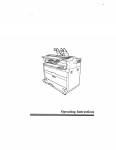



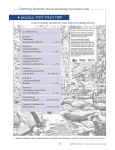
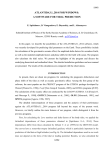
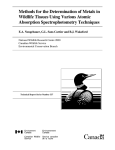
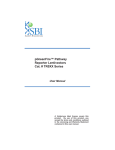

![[ TVS M ASCOT USER M ANUAL ] - TVS-E](http://vs1.manualzilla.com/store/data/005862685_1-4bbb7317613bf954ee62497b52c82516-150x150.png)
